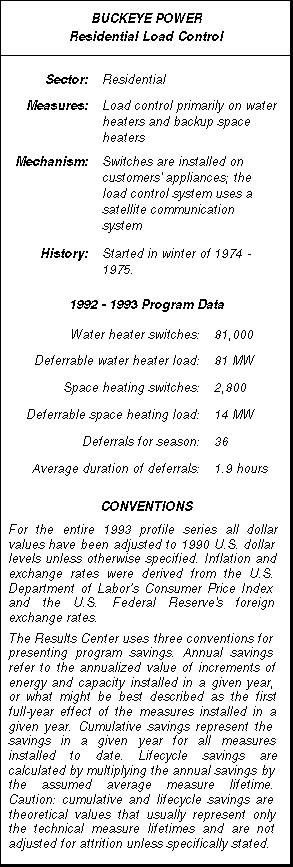IIEC Recent News
Buckeye Power, Residential Load Control, Profile #58
EXECUTIVE SUMMARY
 Buckeye Power’s Residential Load Control program is offered to the member consumers of each of its 27 member cooperatives. Through the program, 81,000 residential electric water heaters throughout the Buckeye service area may be controlled during peak demand periods. Additionally, approximately 2,800 residential electric space heating systems are controlled through the program.
Buckeye Power’s Residential Load Control program is offered to the member consumers of each of its 27 member cooperatives. Through the program, 81,000 residential electric water heaters throughout the Buckeye service area may be controlled during peak demand periods. Additionally, approximately 2,800 residential electric space heating systems are controlled through the program.
The primary goal of the Residential Load Control program is to prevent exceedance of the historical record peak demand. Each member cooperative pays a monthly demand charge, which is based on the cooperative’s percentage contribution to the total system demand at the time of the peak of record. Thus, each time a new peak of record occurs, each cooperative’s monthly demand charge is recalculated. The monthly demand charge may increase or decrease, depending on how much demand the cooperative was responsible for at the time of the new peak. As of May 1993, the system peak of record of 967 MW occurred in the evening on December 21, 1989. Through voluntary control and participation in the Residential Load Control program, member cooperatives have successfully limited the frequency with which new system peaks are reached. Prior to the December 1989 peak, Buckeye’s system peak was 912 MW on December 24, 1983.
Each water heater controlled is estimated to save 1 kW. With 81,000 water heaters controlled in the winter of 1992-93, Buckeye had control over 81 MW. In addition, approximately 2,800 switches are installed on electric space heating equipment with average savings of 5 kW per switch, for a deferrable load of 14 MW in 1992-93.
Over the entire period that the program has been implemented, the duration of each water heater deferral has averaged 1.6 hours. The longest deferrals occurred during the winter of 1989-90, when some water heaters were turned off for 6.1 hours.
Space heating deferrals have been occurring since the winter of 1989-90. A total of 13 deferrals have been necessary, for an average of 4.0 hours per deferral.
The program has operated with little need for change in its implementation strategy. Perhaps the biggest changes for the program have been the installation of a new satellite communications system and PC-based central computer control facility. Buckeye evaluates the load control system’s performance with 15 load monitoring points located throughout the service territory. Information from these points is transmitted via the satellite communication system back to Buckeye’s central load control computer. With the success of the Residential Load Control program, Buckeye has shown that with careful planning and foresight, a program can update its equipment to a state-of-the-art system that enhances the program capability, creates opportunities to improve communication within the service territory, and has a favorable payback period.
[CLICK HERE TO DOWNLOAD THE ENTIRE 17 PAGE PROFILE IN PDF FILE FORMAT]
This profile was produced by 

